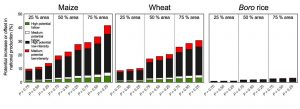Bringing Fallows into Cultivation in Southern Bangladesh

South Asia’s increasing population, movement out of poverty, and changing dietary preferences indicate that food demand is likely to continue increasing. Since the 1960s, however, the average increase in staple crop yields has been negligible, while farm area per capita has shrunk by 63 percent to approximately 0.1 hectare per person. As most arable farmland is already cultivated, how can farmers increase the production of staple foods, including rice, wheat and maize?
Sustainable intensification (SI), a guiding principle behind the Cereal Systems Initiative for South Asia’s (CSISA) interventions, helps increase productivity by maximizing resource use efficiency while minimizing environmental tradeoffs. SI often involves increasing the number of crops grown per year on the same land, thereby raising the yield per unit of area-time, while minimizing land expansion. However, to get more productivity out of the same land, farmers need access to irrigation. In southern Bangladesh, where CSISA works, farmers have traditionally relied on rainfed cultivation, so overcoming moisture constraints during the dry season has become an imminent challenge.
The Government of Bangladesh recently adopted a policy calling for investment of over US$ 7 billion to support agricultural development in southern Bangladesh. Of these funds, US$ 500 million is to be allocated for surface water irrigation to transition farmers from monsoon rice-fallow or rainfed systems into intensified double cropping systems. However, precise geospatial assessments of where freshwater flows are most prominent and where viable fallow and rainfed cropland is most common have been unavailable. CSISA has helped to fill the gap by analyzing remotely sensed data and yields measured from over 1,600 farmers for 33,750 square kilometers of the Feed the Future (FtF) zone in southwestern Bangladesh.

Modeled results describing the potential contribution of surface water irrigated winter rice, wheat and maize to national aggregate production in Bangladesh (click to enlarge).
The result is an initial scientific estimation of the extent of fallow and rainfed cropland that can be brought under cereal production during the dry season using surface water irrigation. Findings indicate substantial scope for surface water irrigation to intensify cropping, even in the face of soil and water salinity constraints. A total of 20,800 and 103,000 hectares of fallow and rainfed cropped land, respectively, that can be placed under reliable surface water irrigation. Although the potential for winter rice production appears to be more limited than anticipated, projections of dry season cultivation of wheat or maize result show significant potential for production increases, with important implications for national food security. These crops also address income generation constraints while minimizing water pumping and withdrawals, helping to minimize environmental risks.
Building on this work, CSISA has undertaken a convening role with NARES, government and private sector partners to discuss policy and market interventions that can lay the foundations for an environment to enable both surface water irrigation and rainfed legume crop intensification in the FtF zone.
Balancing Risks and Benefits Winter rice cultivation helped Bangladesh increase its total rice production from 18.3 million tons in 1991 to 33.8 million tons in 2013, but at the cost of exploitation of groundwater in particular environments in northern Bangladesh resulting from unrestrained shallow tube well installation. CSISA’s interventions on cropping intensification in southern Bangladesh look beyond surface water irrigation to ensure long-term environmental sustainability. While research results support the targeted use of surface water irrigation alongside improved water governance measures, CSISA continues to explore more viable crop diversification options.
Recommended Reading: What Contribution Can Surface Water Irrigation Make to Crop Intensification in Bangladesh’s Feed the Future Zone?
This article is authored by Timothy J. Krupnik, CIMMYT Systems Agronomist and Ashwamegh Banerjee, Assistant Communications Specialist, CSISA.
